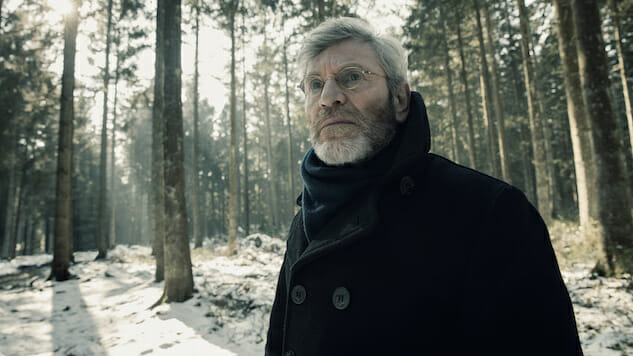The Missing Returns with an Icily Compelling Second Season
Starz/Company Television Production TV Reviews The Missing
Every TV series focused on child abduction has one moment that must be gauged correctly. If handled poorly, it can throw an entire season off balance: What is the point, after all, of a story that builds toward a single event and then has no idea how to bring everything together? In such stories, the reunification of parent and child is often the climactic sequence—we wait the entire narrative to reach it. Yet, The Missing’s second season structures its story so that we see the sequence in the premiere, instead—and it’s handled beautifully. The dialogue is reduced to a minimum, the visual canvas is limited to the whites of a hospital room and the camera lingers in close up for the whole ordeal. The framing oozes intimacy but the color palette screams isolation.
Showrunners Jack and Harry Williams clearly have a talent for this kind of scene. In The Missing’s first season, they subverted the viewer’s expectations by refusing to make clear whether or not the conclusion of Tony and Emily Hughes’ (James Nesbitt and Frances O’Connor) search for their son, Oliver, was in fact one final red herring. In Season Two, we again follow French detective Julien Baptiste (Tchéky Karyo), now tasked with investigating the abduction of Alice Webster (Abigail Hardingham) after she returns to her parents, Sam (David Morrissey) and Gemma (Keeley Hawes), 11 years later. Much like in Season One, The Missing depicts this in a dual timeline structure: Alice’s reappearance occurs in 2014, while Baptiste resumes his investigation in 2016.
This dual timeline was the savior of The Missing’s debut season, and its strengths are spotlighted here. The 2016 sequences reveal information that characters are oblivious to in 2014, placing us in a powerful position for half of the narrative. Characters also wind up in certain places by 2016 that seem impossible in 2014, adding an “unexploded bomb” feel to the earlier sequences. We know, for example, that Sam and Gemma will be a damaged and distant couple by 2016: The intrigue lies in their path to this disconnection. The season premiere, “Come Home” even reveals to us that Julien is dying from a brain tumor in 2016. The Missing uses this notion, which is hardly a fresh idea in itself, to add a breathless urgency to both timelines—we need Julien to work through enough of the case before his diagnosis in 2014 as well as catch the culprit before he dies in 2016.
It allows Karyo to add significant depth to a figure we already admire. If Season One opens a door onto Julien’s world—we understand how loved and respected he is by his family, and how selfless he is when it comes to his work—his battle with cancer in Season Two forces him to act more confrontationally than ever before. He exudes warmth and aggression in equal measure—his gentleness towards the Websters after they’re reunited with their daughter is a far cry away from the cold and almost frighteningly determined man we see when the episode jumps to 2016 for the first time. The Missing thus uses the anthology format to underline Julien’s darker side: Had he been an entirely new character, the tumor subplot might have felt clichéd and patronizing, but here it creates narrative momentum and emotional weight.
Aided by Morrissey and Hawes’ consummate performances, the series’ cinematography digs into the characters as well: In the sequences set in 2014, for instance, Sam and Gemma are always framed together, but in the sequences set in 2016, they’re kept at opposite ends of corridors. Indeed, as in Season One, The Missing offers an unflinching depiction of a horrific ordeal—the disappearance of a child—in impressive visual terms: Huge, daunting establishing shots contrast with intimate close-ups; unexpected camera angles highlight evolving character dynamics; warm, familiar sequences seem suspended within episodes defined by their cold, icy settings. The series’ palette is almost glacial, an absence of color that reflect the emotionally draining experience that Sam and Gemma go through.
If the new season’s characters occasionally feel uninspired in the early going—at first, everything seems to follow the path we expect it to—the second half of the season works to correct this. Indeed, many of the season’s strengths and weaknesses are bound up in the dual timeline: While it works wonders with its characters in the latter stages, for example, the season stumbles when faced with leaving the 2014 timeline behind in the sixth episode, “Saint John,” abandoning its intricacy and resorts to a handful of questionable coincidences. Still, The Missing’s second season is quite considered about its structure, and it’s rarely smug about how clever it is: In fact, when the pieces start to click together and the real story unfolds, it becomes clear that the sophomore season isn’t smug at all. It’s almost being modest.
Ryan Morris is a film and TV critic whose writing has appeared on Film Inquiry, Starskify, and on his personal website MorrisMovies. He lives in London and tweets about all things film and TV @ryannn_13.